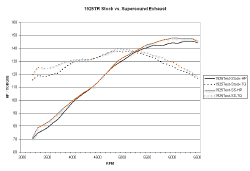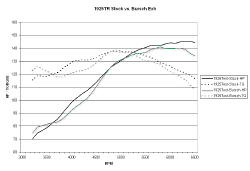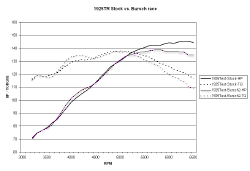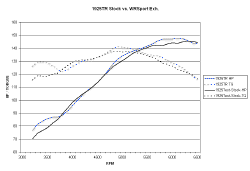|
Performed at Carobu
Engineering on their DTS engine dyno, the weekend of the LA Lit Meet.
We performed four comparisons
using our latest 1925TR Engine with a Stock Dansk Muffler, the NLA Dansk
Supersound Muffler, the Bursch 1.5" header (with street muffler and race
stinger), and the WR 1925TR Sport Muffler.
The 1925TR is very streetable but is by no means a mild engine. The peak power
is at 6000 rpm and peak torque is around 5000 rpm. These are recorded during a
full throttle sweep from 3200-6500 rpm in which the performance is recorded and
calculated by the dyno at 100 rpm intervals.
The dyno also plots the fuel
curve at 100 rpm intervals across the entire run using a lambda sensor. In the
356 engine there is always a dip (richness) in this curve just below peak
torque, which is made worse by the use of a sport cam. The tuning and back
pressure of the exhaust can help this (as you'll see in the tests), but it can't
be eliminated with carburetors, which depend on the intake vacuum signal to
atomize the fuel. EFI can eliminate the fuel curve issues because it can be
tuned based on throttle position and rpm, not vacuum, but because of the
increased overlap with a sport cam, there will always be some power loss at
lower rpm (below peak torque). On these tests, carb jetting was only changed
with the Bursch Racing Header.
Both the Stock and Supersound
mufflers backfired on deceleration after the full power sweep on the dyno. One
possible explanation is that these exhausts have too much restiction for the
1925cc engine with the sport camshaft.
Keep in mind that these test
were performed with an engine that produces over 50hp more than the most
powerful stock 356. The fact that the stock muffler did so well says a lot for
the guys at the factory. It is possible that the comparisons could be different
on a completely stock engine.
All runs on the DTS dyno are
corrected for ambient temperature and air density. The 1925TR engine has been
extensively tested and the performance figures shown here are very repeatable
and consistent.
Test#1
This shows the horsepower and
torque curves of the Stock Muffler vs. the NLA Supersound. The Supersound
has a different sound than stock, much deeper, but with the added chrome
resonator tips sounds too much like a VW. The Stock and Supersound both make
good low end torque. They both tended to lean out the richness in the fuel curve
between 3500 rpm and 4500rpm and this helped the lower end torque. The
Supersound made more top end power but for no really obvious reason (probably
because of slightly less back pressure but it's difficult to say for
sure).
If you run a Supersound vs. a
Stock muffler you might be able to tell the difference in
performance...you'll definitely hear the difference.

Click
graph for larger version
Test #2
This test shows the Stock vs. the
Bursch Header with a street muffler attachment. Low end torque is way down
but the tuning of the individual runners seems to help under 3500 rpm. The
top end suffers as well and we don't have any real explanation, except that the
fuel curve has gone very lean overall. This could actually be the reason for the
improvement under 3500 rpm. My guess is that the street muffler attachment on
the Bursch is too restrictive.
Without question, the Bursch
exhaust dramatically affects the fuel curve and shouldn't be used without
testing for a lean condition, either on an engine or chassis dyno.

Click
graph for larger version
Test #3
Since many Bursch systems are
used on the track, we thought it would be fair to try the Bursch with a straight
pipe "stinger." We also removed the air cleaners for maximum air flow
into the carbs. The main jets were increased form 135 to 145 to correct the lean
condition encountered on the last run. The improvement in the fuel curve brought
a dramatic change in performance compared to the last run, but the results of
the Bursch Race Header were disappointing, since it couldn't duplicate the
performance of the stock exhaust. With more time on the dyno, it might be
possible to optimize the fuel curve and improve the top end, since the curve
with the 145 main jets was a little too rich.
This test does show that sound
can definitely make you feel like you're going faster.

Click
graph for larger version
Test #4
The
last test compares the Stock muffler to our WR 1925TR Sport Exhaust. This is a
hollow can-type muffler with equal length primary pipes entering the can. The
inside of the can is empty but the stainless exit pipes have internal
resonators. It is the loudest of the mufflers and has a very different sound,
with very low back pressure. It will not work with the stock J tube heaters and
is specially designed to clear the lower plug wires on the twin plug engine. The
equal length pipes boost the very low rpm torque and the low restriction design
carries the power into the higher rpm. The
WR 1925TR Sport Exhaust is a good balance of performance and looks on a 356...it
is also about 3.5 times the cost of the other exhausts.

Click
graph for larger version
| 
